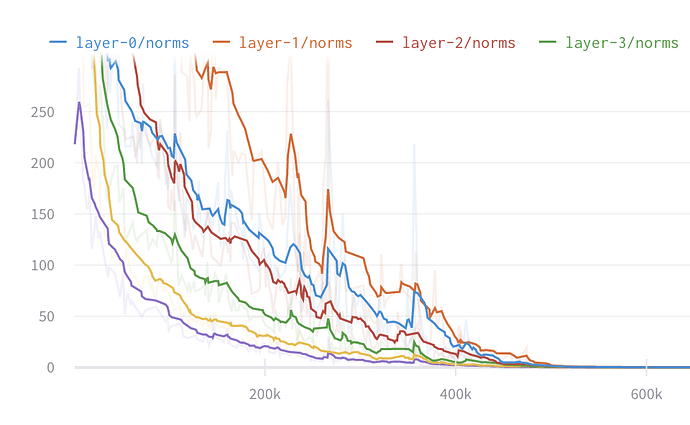Hi,
I implemented Hessian and Fisher Information matrix (FIM) vector products and was wondering if there’d be interest in adding this functionality. The FIM products are optimized, in the sense that they analytically compute the Hessian matrix of the logarithm of the loss wrt. the output layer for a set of commonly used losses.
Best,
P.
Edit: Tagging you in
@smth, @apaszke
Editing for posterity since no one wants to discuss how to submit this PR.
import numpy as np
import torch
def _check_param_device(param, old_param_device):
r"""This helper function is to check if the parameters are located
in the same device. Currently, the conversion between model parameters
and single vector form is not supported for multiple allocations,
e.g. parameters in different GPUs, or mixture of CPU/GPU.
Arguments:
param ([Tensor]): a Tensor of a parameter of a model
old_param_device (int): the device where the first parameter of a
model is allocated.
Returns:
old_param_device (int): report device for the first time
"""
# Meet the first parameter
if old_param_device is None:
old_param_device = param.get_device() if param.is_cuda else -1
else:
warn = False
if param.is_cuda: # Check if in same GPU
warn = (param.get_device() != old_param_device)
else: # Check if in CPU
warn = (old_param_device != -1)
if warn:
raise TypeError('Found two parameters on different devices, '
'this is currently not supported.')
return old_param_device
def vector_to_parameter_list(vec, parameters):
r"""Convert one vector to the parameter list
Arguments:
vec (Tensor): a single vector represents the parameters of a model.
parameters (Iterable[Tensor]): an iterator of Tensors that are the
parameters of a model.
"""
# Ensure vec of type Tensor
if not isinstance(vec, torch.Tensor):
raise TypeError('expected torch.Tensor, but got: {}'
.format(torch.typename(vec)))
# Flag for the device where the parameter is located
param_device = None
params_new = []
# Pointer for slicing the vector for each parameter
pointer = 0
for param in parameters:
# Ensure the parameters are located in the same device
param_device = _check_param_device(param, param_device)
# The length of the parameter
num_param = param.numel()
# Slice the vector, reshape it, and replace the old data of the parameter
param_new = vec[pointer:pointer + num_param].view_as(param).data
params_new.append(param_new)
# Increment the pointer
pointer += num_param
return list(params_new)
def Rop(ys, xs, vs):
if isinstance(ys, tuple):
ws = [torch.tensor(torch.zeros_like(y), requires_grad=True) for y in ys]
else:
ws = torch.tensor(torch.zeros_like(ys), requires_grad=True)
gs = torch.autograd.grad(ys, xs, grad_outputs=ws, create_graph=True, retain_graph=True, allow_unused=True)
re = torch.autograd.grad(gs, ws, grad_outputs=vs, create_graph=True, retain_graph=True, allow_unused=True)
return tuple([j.detach() for j in re])
def Lop(ys, xs, ws):
vJ = torch.autograd.grad(ys, xs, grad_outputs=ws, create_graph=True, retain_graph=True, allow_unused=True)
return tuple([j.detach() for j in vJ])
def HesssianVectorProduct(f, x, v):
df_dx = torch.autograd.grad(f, x, create_graph=True, retain_graph=True)
Hv = Rop(df_dx, x, v)
return tuple([j.detach() for j in Hv])
def FisherVectorProduct(loss, output, model, vp):
Jv = Rop(output, list(model.parameters()), vp)
batch, dims = output.size(0), output.size(1)
if loss.grad_fn.__class__.__name__ == 'NllLossBackward':
outputsoftmax = torch.nn.functional.softmax(output, dim=1)
M = torch.zeros(batch, dims, dims).cuda() if outputsoftmax.is_cuda else torch.zeros(batch, dims, dims)
M.reshape(batch, -1)[:, ::dims + 1] = outputsoftmax
H = M - torch.einsum('bi,bj->bij', (outputsoftmax, outputsoftmax))
HJv = [torch.squeeze(H @ torch.unsqueeze(Jv[0],
-1)) / batch]
else:
HJv = HesssianVectorProduct(loss, output, Jv)
JHJv = Lop(output, list(model.parameters()), HJv)
return torch.cat([torch.flatten(v) for v in JHJv])
